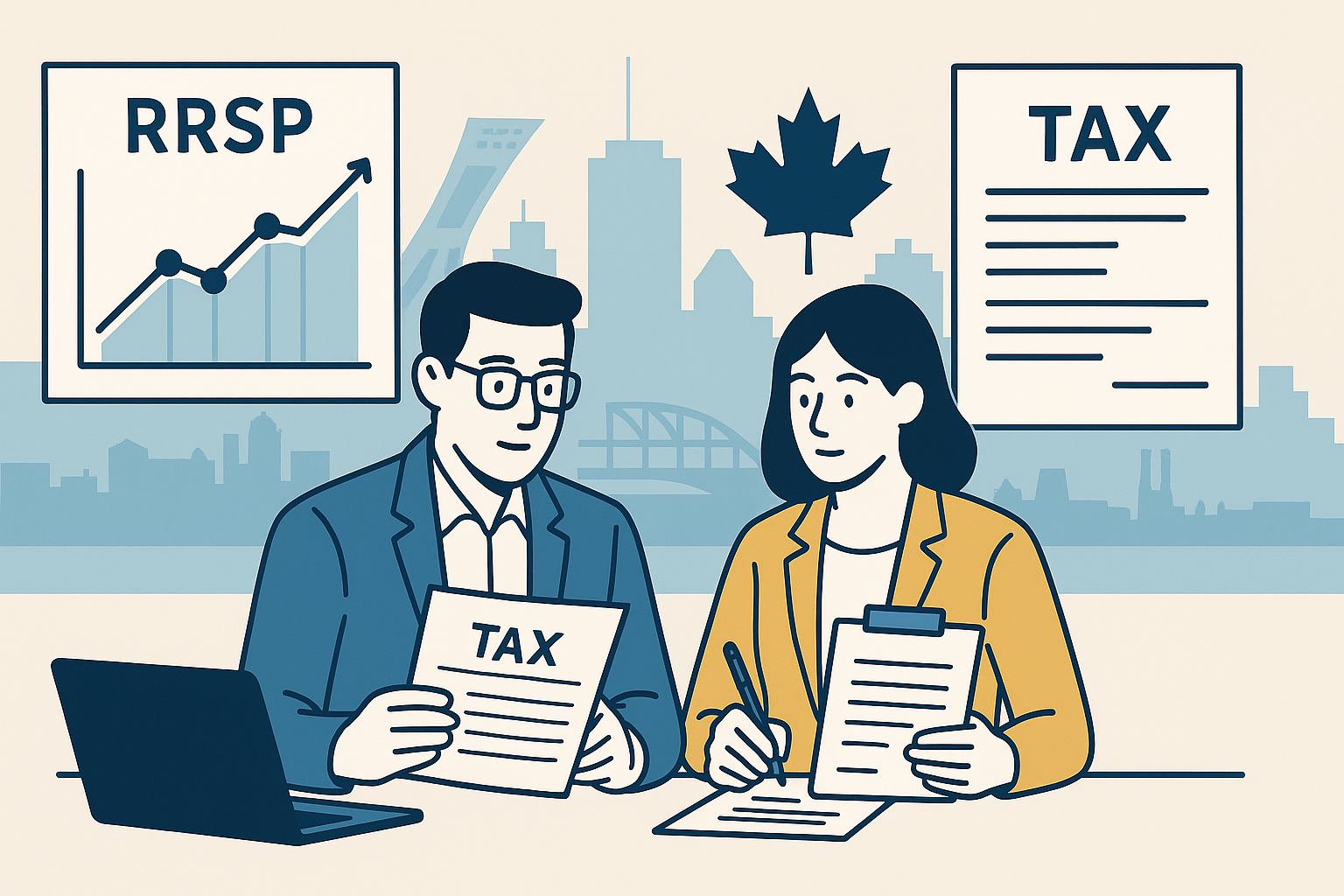For many Quebecers, RRSP season comes with two big questions:
-
How much should I contribute?
-
How do I get the biggest tax benefit from my RRSP?
The good news: every dollar you contribute to an RRSP (within your limit) can reduce your federal and Quebec provincial taxable income. That means less income tax now, more money working for your retirement.
This guide explains, in simple terms, how RRSPs lower your tax bill, the key deadlines and rules Quebec residents must know, and practical strategies to get the most out of your contribution room.
1. RRSP basics: how the tax break actually works
An RRSP is a registered account that lets your investments grow tax-deferred. But the real magic is the tax deduction you get when you contribute.
RRSP deduction = lower taxable income
When you contribute to an RRSP, you can usually deduct that amount from your income on your tax return. This reduces your taxable income at both levels of government:
-
Federal return: you claim the deduction on line 20800.
-
Quebec return: you claim the corresponding RRSP/PRPP/VRSP deduction on line 214 of the TP-1 return. Revenu Québec explicitly ties the line-214 deduction to the RRSP deduction you claim federally.
In other words, the same RRSP contribution reduces income used to calculate both your federal and provincial income tax.
Your RRSP contribution limit
Your personal RRSP limit is shown on your CRA Notice of Assessment or in your CRA “My Account.” The basic rule:
-
You can contribute up to 18% of your previous year’s earned income,
-
Up to a yearly maximum set by the CRA,
Recent annual maximums:
-
2024 tax year: $31,560
-
2025 tax year: $32,490
You can keep contributing to your own RRSP until December 31 of the year you turn 71.
2. How RRSP contributions lower your tax bill in Quebec
Let’s look at the mechanics for Quebec residents.
Step 1: RRSP contribution → tax deduction
Suppose:
-
You earn $70,000 of employment income.
-
You contribute $8,000 to your RRSP.
On your tax returns, you claim an $8,000 RRSP deduction. Your taxable income drops from $70,000 to $62,000. You now pay tax as if you only earned $62,000.
Because Quebecers pay both federal and provincial tax, the combined marginal tax rate (the rate on your last dollars of income) can easily be 35–45% for middle-income households. That means, very roughly:
-
If your combined marginal rate is 40%,
-
Every $1,000 of RRSP contribution can save you about $400 in tax.
(Exact numbers depend on your brackets, credits, and situation, but the principle is the same.)
Step 2: Lower income can increase Quebec tax credits
RRSP deductions don’t just shave income tax—they can also lower the “family income” used to calculate some income-tested Quebec benefits and credits.
For example:
-
The solidarity tax credit is reduced as your family income (line 275 on your Quebec return) goes up.
-
RRSP contributions reduce your net income before that calculation, which can help you qualify for a higher credit or avoid a clawback.
For lower- and middle-income Quebecers, this combination—less tax + higher refundable credits—can significantly boost the value of an RRSP contribution.
Step 3: Turn your refund into more savings
If your employer has already withheld tax from your paycheque, your RRSP deduction often results in a tax refund.
Smart move: instead of spending the refund, reinvest it:
-
Add it to your RRSP (if you still have room)
-
Or build an emergency fund or TFSA to keep your finances flexible

3. RRSP deadlines Quebecers absolutely must know
RRSP rules are federal, but they apply equally to Quebec residents. Here are the dates that matter.
Annual contribution deadline (for last year’s taxes)
To claim a deduction for a specific tax year, you must contribute to your RRSP during the year or in the first 60 days of the following year.
Key dates (at the time of writing):
-
2024 tax year: RRSP deadline is March 3, 2025 (because March 1 falls on a weekend, the CRA deadline moves to the next business day).
In general, think of it this way:
Contribution period for a tax year = March 1 of that year to the first 60 days of the next year.
Contributions made in those first 60 days can be deducted either on:
-
Your previous year’s tax return, or
-
The current year’s return,
whichever is more advantageous for you.
Age limit to contribute
-
You can contribute to your own RRSP until December 31 of the year you turn 71.
-
After that, you generally convert your RRSP to a RRIF or purchase an annuity.
Quebec return specifics
On your Quebec TP-1 return:
-
Claim your RRSP/PRPP/VRSP deduction on line 214.
-
The amount must match the RRSP deduction on your federal return (line 20800) for the same year.
This ensures your RRSP contributions reduce both your Quebec net income (line 275) and your taxable income, which matters for tax and income-tested credits like the solidarity tax credit.
4. The big “don’t”: avoid RRSP over-contributions
Going just a bit over your RRSP limit can be expensive.
-
The CRA allows a $2,000 lifetime “buffer” over your RRSP limit with no penalty (but you can’t deduct this excess).
-
If your unused contributions exceed your limit by more than $2,000, you’re generally charged a 1% per month tax on the excess until you fix it.
Example:
If you over-contribute by $5,000:
-
First $2,000: no penalty
-
Remaining $3,000: charged 1% per month → $30 per month until you withdraw it or gain enough new RRSP room
To avoid this:
-
Always check your Notice of Assessment or CRA “My Account” before making large contributions.
-
Keep track of contributions to all RRSPs (personal, spousal, and group plans).
5. Practical strategies to maximize your RRSP as a Quebecer
Now that you know the basics, here are actionable ways to get more value from each contribution.
5.1 Match your contribution to your tax bracket
RRSPs are most powerful when you:
-
Contribute while in a higher tax bracket, and
-
Withdraw later in retirement when you’re likely in a lower bracket.
Tactics:
-
If this year’s income is unusually high (bonus, overtime, business windfall), consider larger RRSP contributions to offset the higher tax.
-
If your income is currently low (e.g., student, early-career), you can make contributions but carry forward the deduction and use it in a future year when your marginal tax rate is higher.
5.2 Use automatic contributions
Many Quebecers find RRSP season stressful because they wait until February or March to contribute.
Instead:
-
Set up monthly automatic transfers from your chequing account or paycheque.
-
You’ll dollar-cost average into your investments, smooth out market volatility, and avoid a big last-minute cash crunch.
5.3 Coordinate RRSP planning with Quebec credits
Because net income (line 275) affects several Quebec tax credits (solidarity tax credit, work premium, and more), sometimes a carefully sized RRSP contribution can:
-
Keep your family income below a key threshold,
-
Preserve or increase valuable credits.
This is where detailed tax planning—often with a professional—can really pay off.
5.4 Don’t forget spousal RRSPs
If one spouse expects to be in a much lower income bracket in retirement, a spousal RRSP can help split income and reduce future taxes. Contributions still use the contributor’s RRSP room today but may be taxed at the other spouse’s lower rate when withdrawn.
6. RRSP vs TFSA: which should come first?
Both RRSPs and TFSAs are excellent tools, and many Quebecers need both. A quick rule of thumb:
-
If you are in a higher tax bracket now and expect a lower bracket later → RRSP tends to be more powerful, especially considering Quebec + federal tax rates.
-
If your income is modest or variable, or you want flexible access to savings → TFSA may be better (no tax on withdrawals and no impact on taxable income or many benefits).
A common strategy:
-
Maximize your employer pension/VRSP match (if any),
-
Contribute enough to RRSP to significantly reduce tax,
-
Use a TFSA for additional flexible savings.
7. Key RRSP takeaways for Quebecers
To recap:
-
RRSP contributions reduce both federal and Quebec taxable income, lowering your overall tax bill.
-
For the 2024 tax year, the contribution deadline is March 3, 2025; the general rule is first 60 days of the following year.
-
Your RRSP room equals 18% of last year’s earned income up to annual caps ($31,560 for 2024, $32,490 for 2025), plus unused room.
-
Quebecers claim the RRSP deduction on line 214 of the TP-1, matching the federal deduction on line 20800.
-
Avoid over-contributing: amounts more than $2,000 over your limit can be hit with a 1% per month penalty until fixed.
8. FAQs: RRSP contributions and Quebec taxes
What is the RRSP deadline for the 2024 tax year?
For the 2024 tax year, you have until March 3, 2025 to make RRSP contributions that you can deduct on your 2024 return.
Do RRSP contributions reduce Quebec provincial tax as well as federal?
Yes. The RRSP deduction you claim federally is also claimed on your Quebec TP-1 return (line 214), reducing your net income and taxable income at both levels.
How much can I contribute to my RRSP in 2025?
For the 2025 tax year, the maximum RRSP limit is $32,490, or 18% of your 2024 earned income, whichever is lower, plus any unused room. Check your CRA Notice of Assessment for your exact limit.
I live in Quebec. Can RRSP contributions increase my solidarity tax credit?
They can. The solidarity tax credit is based on your family income (line 275 on your Quebec return). RRSP deductions reduce this income, which can help you qualify for a larger credit or avoid reductions if you’re near the income thresholds.
Final word (and a gentle disclaimer)
RRSP rules and limits change regularly, and the best strategy depends on your income, family situation, and retirement goals. The information above is general only and current as of late 2025.
Before making major RRSP moves—especially if you’re close to your limit or trying to coordinate with Quebec tax credits—it’s wise to speak with a licensed tax professional or financial planner.
Still unsure how much to contribute to your RRSP?
Talk to an Info C Plus advisor and see how different contribution scenarios could affect your Quebec and federal taxes.
👉 Contact us now to get a personalized RRSP optimization plan.



